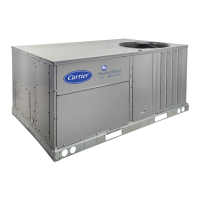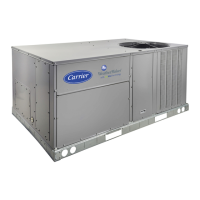106
P120 (Circuit A Low Saturated Suction Temperature —
Compressor A2 Shutdown)
T120 (Circuit A Low Saturated Suction Temperature Alert)
A120 (Circuit A Low Saturated Suction Temperature Alarm)
P121 (Circuit B Low Saturated Suction Temperature —
Compressor B2 Shutdown)
T121 (Circuit B Low Saturated Suction Temperature Alert)
A121 (Circuit B Low Saturated Suction Temperature Alarm)
This alert/alarm is used to keep the evaporator coils from freez-
ing and the saturated suction temperature above the low limit
for the compressors.
T122 (Circuit A High Saturated Suction Temperature)
T123 (Circuit B High Saturated Suction Temperature)
Alert codes 122 and 123 occur when compressors in a circuit
have been running for at least 5 to 30 minutes (Configuration
COOL
H.SST). This alert code occurs if the circuit satu-
rated suction temperature is greater than 65°F when one com-
pressor is running or 60°F when two compressors are running.
For all units, the high saturated suction alert is generated and
the circuit is shut down. Alert code 122 is for circuit A and 123
for circuit B.
LRTA High Saturated Condensing Temperature Alert/Alarm
P126 (Circuit A High Head Pressure, Comp Shutdown)
T126 (Circuit A High Head Pressure Alert)
A126 (Circuit A High Head Pressure Alarm)
P127 (Circuit B High Head Pressure, Comp Shutdown)
T127 (Circuit B High Head Pressure Alert)
A127 (Circuit B High Head Pressure Alarm)
This alert/alarm is used to keep the saturated condensing tem-
perature below maximum recommended compressor operating
pressure. This alert/alarm attempts to prevent the saturated
condensing temperature from reaching the high pressure
switch trip point by reducing the number of compressors oper-
ating on a circuit.
When the saturated condensing temperature on a circuit is
greater than 145°F, no compressors will be added to the circuit.
When temperatures REF.T, SCTA, or temperatures REF.T,
SCTB rise above 150°F, a compressor of the affected circuit
will be immediately shut down with pre-alert (P126,P127) and
a 10-minute timeguard will be added to the compressor. If the
saturated condensing temperature remains above 150°F for 10
more seconds, another compressor of the affected circuit, if it
exists, will be shut down with pre-alert (P126, P127) and a 10-
minute timeguard will be added to the compressor. This se-
quence will continue until the last compressor on the circuit is
shut down, at which time the circuit will be shut down with
alert (T126, T127).
This failure follows a three strike methodology. When the cir-
cuit is shut down entirely, an alert (T126, T127) is generated
and a strike is logged on the circuit. On the third strike, alarm
(A126, A127) will be generated which will necessitate a manu-
al reset to get the circuit back running. It is important to note
that a strike is called out only if all compressors in the circuit
are off at the time of the alert.
To prevent nuisance alerts, P126 and P127 show up in the
alarm history and locally at the display, but are never broadcast
to the network. To recover from these alerts, both a 10-minute
hold off timer and saturated condensing temperature returning
under the compressor envelope must occur. If recovery occurs,
staging will be allowed on the circuit once again. Again, a
strike is tied to the circuit going off entirely, not reducing ca-
pacity and recovering. Therefore, it is possible that multiple
P126 and P127 alerts may be stored in alarm history but not
broadcast.
T128 (Digital Scroll High Discharge Temperature Alert)
A128 (Digital Scroll High Discharge Temperature Alarm)
This alert/alarm is for units with a digital scroll compressor on-
ly. The digital scroll compressor is equipped with a tempera-
ture thermistor that is attached to the discharge line of the com-
pressor. The alert occurs when the discharge temperature
thermistor has measured a temperature above 268°F or the
thermistor is short circuited. The digital scroll compressor will
be shut down and alert T128 will be generated. The compres-
sor will be allowed to restart after a 30-minute delay and after
the thermistor temperature is below 250°F. If five high dis-
charge temperature alerts have occurred within four hours,
alarm A128 will be generated which will necessitate a manual
reset to start the compressor.
There will be a start-up delay if the outside-air temperature is
too low. When the outdoor ambient is below 60°F, during ini-
tial start-up, saturated suction temperature will be ignored for a
period of 5 minutes. When Temperatures
REF.T
SSTA
or Temperatures
REF.T
SSTB is less than 20°F for 4
minutes, less than 10°F for 2 minutes, less than 0°F for 1 min-
ute or less than –20°F for 20 seconds continuously, the second
compressor of the affected circuit, if it exists, will be shut
down with a local alert (P120, P121) and a 10-minute
timeguard will be added to the compressor. If saturated suction
temperature continues to be less than 20°F for 4 minutes, less
than 10°F for 2 minutes, less than 0°F for 1 minute or less than
–20°F for 20 seconds continuously then compressor no. 1 will
be shut down and then an alert or alarm will be issued.
This failure follows a 3 strike methodology whereby the first
two times a circuit goes down entirely, an alert will be generat-
ed which keeps the circuit off for 15 minutes before allowing
the circuit to try again. The third time this happens, an alarm
will be generated which will necessitate a manual reset to get
the circuit back running. It is important to note that a “strike” is
called out only if all compressors in the circuit are off at the
time of alert/alarm.
To prevent nuisance alerts, P120 and P121 show up in the
alarm history and locally at the display but are not broadcast to
the network. To recover from these alerts, a 10-minute holdoff
timer must elapse and the saturated suction temperature must
rise above 29.32°F. If recovery occurs, staging will be allowed
on the circuit again. Again, a “strike” is tied to the circuit going
off entirely, not reducing capacity and recovering. Therefore it
is possible that multiple P120 or P121 alerts may be stored in
alarm history but not broadcast.
If there are 1 or 2 strikes on the circuit and the circuit recovers
for a period of time, it is possible to clear out the strikes there-
by resetting the strike counter automatically. The control must
have saturated suction temperature greater than or equal to
34°F for 60 minutes in order to reset the strike counters.
A140 (Reverse Rotation Detected)
A test is made once, on power up, for suction pressure change
on the first activated circuit. The unit control determines fail-
ure is as follows:
The suction pressure of both circuits is sampled 5 seconds be-
fore the compressor is brought on, right when the compressor
is brought on and 5 seconds afterwards. The rate of suction
pressure change from 5 seconds before the compressor is
brought on to when the compressor is brought on is calculated.
Then the rate of suction pressure change from when the com-
pressor is brought on to 5 seconds afterwards is calculated.
With the above information, the test for reverse rotation is
made. If the suction pressure change 5 seconds after compres-
sion is greater than the suction pressure change 5 seconds be-
fore compression – 1.25, then there is a reverse rotation error.

